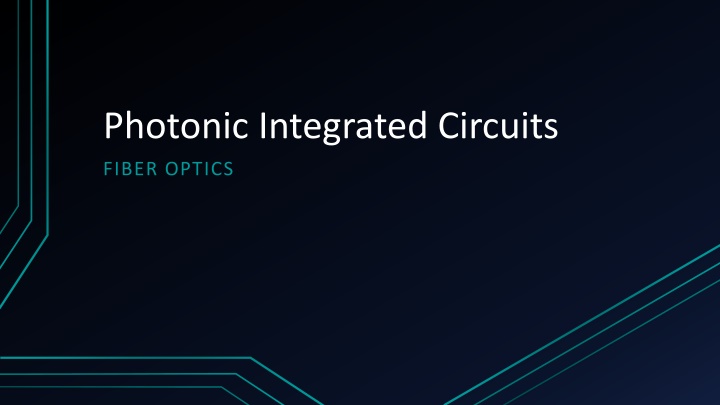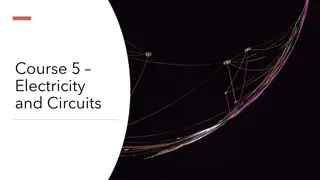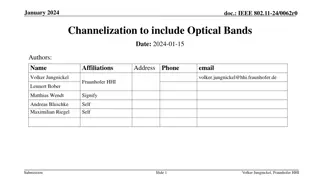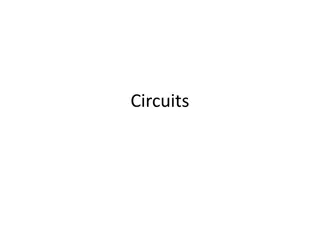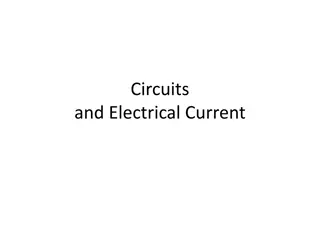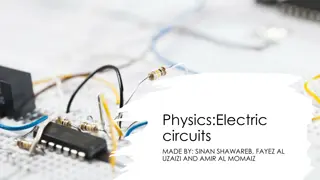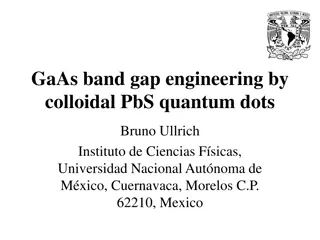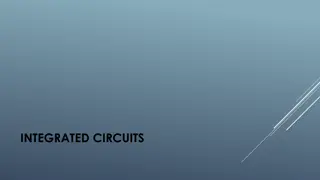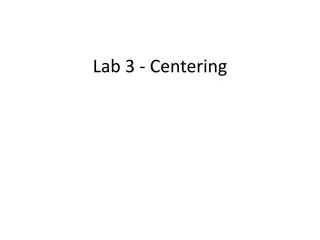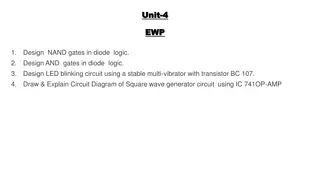Evolution of Optical Technology: From Telegraph to Photonic Integrated Circuits
The journey of optical technology evolution spans from the invention of the telegraph in 1836, through the introduction of optical fibers in 1978, to the development of photonic integrated circuits in the present era. Key milestones include the advent of optical amplifiers in 1990, the emergence of WDM technology in 1996, and the advancements in multiple bands in 2002. This historical perspective showcases the transformation from the electrical era to the optical era, marking significant progress in telecommunications.
Download Presentation

Please find below an Image/Link to download the presentation.
The content on the website is provided AS IS for your information and personal use only. It may not be sold, licensed, or shared on other websites without obtaining consent from the author.If you encounter any issues during the download, it is possible that the publisher has removed the file from their server.
You are allowed to download the files provided on this website for personal or commercial use, subject to the condition that they are used lawfully. All files are the property of their respective owners.
The content on the website is provided AS IS for your information and personal use only. It may not be sold, licensed, or shared on other websites without obtaining consent from the author.
E N D
Presentation Transcript
Photonic Integrated Circuits FIBER OPTICS
Historical Perspective OPTICAL ERA ELECTRICAL ERA Optical Fibers 1978 Telegraph 1836 Optical Amplifiers 1990 WDM Technology 1996 Multiple bands 2002 Telephone 1876 Coaxial Cables 1840 Microwaves 1948 Microwaves and coaxial cables limited to B ~ 100Mbps Optical systems can operate at bit rate > 10 Tbps Improvement in system capacity is related to the high frequency of the optical waves ( ~ 200THz at 1.5 m)
Information Revolution Industrial revolution of 19th century gave way to information revolution during 1990s. Fiber-Optic Revolution is a natural consequence of the Internet growth.
Five Generations 0.8- m systems (1980); 1.3- m systems (1985); 1.55- m systems (1990); WDM systems (1996); L and S bands (2002); Graded-index fibers Single-mode fibers Single-mode lasers Optical Amplifiers Raman Amplification
Lightwave System Components Generic System Receiver Module Transmitter Module
The Optical Fiber In its simplest form an optical fiber consists of a cylindrical core of silica glass surrounded by a cladding whose refractive index is lower than that of the core. Because of an abrupt index change at the core cladding interface, such fibers are called step-index fibers. In a different type of fiber, known as graded-index fiber, the refractive index decreases gradually inside the core. Geometrical optics description : core radius a is much larger than the light wavelength Wave Propagation theory : core radius a is comparable to the light wavelength
PROPAGATION MODES IN FIBERS STEP-INDEX FIBERS GRADED INDEX FIBERS FIBER MODE THEORY SINGLE MODE FIBERS
Step Index Fibers Total Internal Reflection is the mechanism responsible for waveguiding !!! Using the Snell s law at the core facet we get ? 2 ? = ?1 1 sin2? ?0sin??= ?1sin??= ?1sin Total internal reflection takes place between the core (?1) and the cladding (?2) for angles larger that a critical angle ??. For ? = ?? ?1sin??= ?2 2?1 2= 2 ?2 2= ?? ?0sin??= ?1 1 ?2 ?1 Numerical Aperture (NA) represents the light-gathering capacity of an optical fiber.
Step Index Fibers For ?1 ?2 ?? = ?12 1/2, = (?1 ?2)/?1 should be made as large as possible to couple maximum light into the fiber. However these fibers are not useful due to the phenomenon known as intermodal dispersion. Intermodal Dispersion : different rays travel along paths of different lengths. A short pulse would broaden considerably as a result of different path lengths.
Intermodal Dispersion The Path PL depends on the propagating angle ? ?? = sin?
Intermodal Dispersion The shortest path is accomplished for a ray with ? = ?/2 ?????= ? The longest path is accomplished for a ray with ? = ?? ?????= ? sin?? ? ?1 the time delay is By taking the velocity propagation ? = 2 ? =?1 ????? ????? =?1 ? ? =? ?1 ?2 ? ? sin?? ? By increasing we simultaneously increase the numerical aperture and intermodal dispersion !!!
Graded Index Fibers Intermodal dispersion is considerably reduced in this case. The ray velocity changes along the path because of variations in the refractive index. More specifically, the ray propagating along the fiber axis takes the shortest path but travels most slowly as the index is largest along this path. Oblique rays have a large part of their path in a medium of lower refractive index, where they travel faster. It is therefore possible for all rays to arrive together at the fiber output by a suitable choice of the refractive-index profile. The minimum dispersion occurs for ? = 2(1 ) and depends on as 2 8? ? = ??1 Since <1 the maximum delay is far smaller than in the case of step index ( 2 as opposed to ).
Wave Propagation Intermodal dispersion can be eliminated by single mode fibers. The core radius is small enough to allow the propagation of a single ray, also known as mode. However radius a is comparable to the light wavelength and as a result we must abandon the ray approach and focus on the more general wave propagation approach. Maxwell Equations For non-conducting medium with no free charges we have : ? ? = 0 ?? = 0 Vacuum permittivity ?0= 8.854187 10 12 F/m ? ? = ?? ?? ? ? =?? ?? Vacuum permeability ?0= 1.2566370614 10 6 ?/?2 ? = ?0? + ? ? = ?0? + ? = ?0? In silica glass ? is approximately zero !!!
Wave Propagation Applying the curl operator in the third equation = ?0?2? ??= ?0? ? ? ? ? ? = ? ?? ??2 ?? We use the general identity ? ? ? = ? ?? ?2? of vector calculus to write ?2? ??2 ? ?? ?2? = ?0 Rearranging the terms we get the following equation ?2? ??2= ?2? ??2 ?2? ? ?? 1 ?0?0=1 ?2 1 ?2 ?0?2
Wave Propagation We are interested in transverse field which satisfy ?? = 0 The wave equation becomes ?2? ??2= ?2? ??2 ?2? 1 1 ?2 ?0?2 For simplicity we assume a single component of a monochromatic field with frequency ? = ?/2? where ? ?,? = ?,? ? ??? ? ?,? = ? ?,? ? ??? The terms ?,? ,?( ?,?) known as envelopes - vary slowly with time compared to ? ???. Calculating the envelopes and multiplying them by the fast term ? ??? yields the final solutions.
Wave Propagation The equation reduces to ?2 ?,? +?2 ?2 ?0?2?( ?,?) ?2 ?,? = If the medium consists of N particles per unit volume, each of which has a dipole moment ?, the polarization density is ? ?. We assume that the medium has no polarization in the absence of a field. The induced field causes charge displacements that result in an induced dipole moment ? ?,? = ? ? ( ?,?) in an atom at ?. The term ?(?) is known as polarizability. The wave equation becomes ?2 ?,? +?2 ?2 ?,? = ?2 ?0?2?? ? ( ?,?)
Wave Propagation Helmholtz Equation ?2 ?2 ?,? = 0 ?2 ?,? + ?2? 1 ?0??(?) (Refractive Index) ?2? = 1 +
Fiber Modes A mode is a solution of the Helmholtz equation that satisfies the boundary conditions and retains its form during propagation in the fiber. For a cylindrical waveguide we change the Helmholtz equation by introducing cylindrical co-ordinates ? = (?,?,?) instead of ?,?,? . The single component equation becomes ?2 ??2+1 ?2 ??2+?2 ??2+ ?2?2 ? ??+1 c2 = 0 ?2 ?
Fiber Modes Since a rotation by 2 about the axis cannot affect the field a solution must not change when 2 is added to . Thus, must vary with as exp(im ) where ? = 0, 1, 2, For propagation along the z axis the solution is of the form ?,?,? = ? ? ???????? where ? is the propagation constant. The frequency dependence of the envelope is omitted for simplicity ( ?,? = ( ?)). Substituting in the cylindrical Helmholtz equation we obtain for the radial function F(r) the ordinary differential equation ?2?2? ??+ ?2?2?2 ??2+ ??? ?2 ?2 ?2? = 0 It has the form of the Bessel s ordinary differential equation ?2?2? ??2+ ??? ??+ ?2 ?2? = 0
Fiber modes Bessel s ordinary equation has the following solution types First kind : ??(?) Second kind : ??(?) Modified First kind : ??(?) Modified Second kind : ??(?) For a second-order differential equation the solution is the sum of two linearly independent solutions. In case is an integer (as it is in our case) , two possible solutions exist ???? + ? ??(?) ???? + ? ??(?) where A, A , C, C are constants.
Fiber Modes The field must vanish outside the core (r>a) and is allowed to oscillate inside the core (r<a). By comparison between the F(r) differential equation and the general ordinary Bessel equation we get the two solutions ? ? = ????? + ? ???? ,? ? ? ? = ????? + ? ???? ,? > ? 2?2 ?2 ?2, ?2= ?2 ?2 2?2 ?2 where ?2= ?1 The solutions have physical meaning when the field at ? = 0 (center) and ? = (far away) is finite. Observing the form of the Bessel functions it is obvious that we must set A =0 and C =0. The solutions now are ? ? = ????? ,? ? ? ? = ????? ,? > ?
Fiber Modes The electric field solutions are ?,?,? = ????? ????????, ? ? ?,?,? = ????? ????????,? > ? In a similar way the magnetic field solutions are ?,?,? = ????? ????????, ? ? ?,?,? = ????? ????????,? > ? The Helmholtz equation applies to a single component of the electric field envelope (?,?,?), and also to a single component of the magnetic field envelope (?,?,?). Given ?? and ??, for instance, we can obtain ??,??,??,?? from the Maxwell equations.
Fiber Modes Example: Derivation of ?? ? ? = ???0? (1) ? ? = ???? = ???2?0? (2) From (1), considering the ?? component we get ??? ??=??? ???0??=??? ?? ?? ???? (3) From (2) we get ??2?0( ??? Using (4) in (3) and ?0?0= 1/?2, we obtain for the core region (?2= ?1 ? ??+??? ??= ??) (4) 2) ? ??? ?? ???? 2?0 ??= ?2(??1 ??)
Fiber Modes In the same fashion we can derive the components Hx,??,??,?? in the core and cladding regions. The vectors ?,? can be expressed also in terms of cylindrical components ??,??,??,??. We can express the envelopes ?, ?, ?, ? in terms of ?, ? satisfying ??,?,? = ????? ????????, ? ? ??,?,? = ????? ????????,? > ? ??,?,? = ????? ????????, ? ? ??,?,? = ????? ????????,? > ?
Fiber Modes Inside the core (? ?) we get the equations ?2(?? ? ? ? ? ? ? ??) ?= ??+ ?0 ?2(? ? ? ? ?? ?0?? ? ?= ??) ? ?2(?? ? ? 2? ? ? ??) ?= ?0?1 ?? ? ?2(? ? ? ? ??+ ?0?1 2?? ? ?= ??) ? For the cladding region (? > ?) the same equations can be used after replacing ?2 by ?2 and ?1 by ?2.
Fiber Modes The constants A, B, C, D are determined by applying the boundary condition that the tangential components of ?,? be continuous across the core-cladding interface. By requiring the continuity of ?, ?, ?,?? at ? = ? we obtain a set of four homogeneous equations. In order for the solution (A,B,C,D) to be non-trivia ( not equal to zero) the determinant of the coefficient matrix must be zero which leads to the following relation 2 ?? ?? ?? ?? ?? ????? =?2 ?2 ?? ????? ?? ????? 2 1 ?2 +?2 ?1 ?? ????? + 2 1 ?2+1 1 ?2+?2 2 ?2 ?1
Fiber Modes For a given set of parameters ?,?,?1,?2 the values of ? can be determined by the characteristic equation. In general there are multiple solutions, ? = 1,2, , for each integer value m. Each different solution can be denoted as ??? and it defines a mode of the fiber. In general both ? and ? are nonzero (except for m=0). They are referred as hybrid modes and are denoted by ???? or ????, depending on whether ?? or ?? dominates. In the special case m=0, ??0? and ??0? are denoted by ??0? and ??0? since they correspond to transverse-electric (??= 0) and transverse- magnetic (??= 0) modes of propagation. A different notation ???? is sometimes used for weakly guiding fibers for which both ??,?? are nearly zero (LP stands for linearly polarized modes).
Fiber Modes Guided and Unguided Modes We are interested in guided modes in which the electric and magnetic fields fall off with radial distance from the fiber. For ?? 1 inside the cladding layer we get 1 2 ? ? ?? ???? = 2?? ?2> 0:? ?? and the field decays. The mode is guided. ?2< 0:? ??= ? ? ? ?= cos ? ? ? ??? ? ? , it holds no physical meaning and the mode is unguided. ?2= 0defines the cut-off between guided and unguided modes.
Fiber Modes 2?2 ?2 and ?2=?2 2 ?2 2 For ?2= 0 ?2= ?2 Normalized propagation constant b ?2?1 ? = (?? ? ?2)/(?1 ?2) For ? 0 the mode is unguided. V Parameter (Dimensionless) ? = ?? =? 2=?? 2 ?2 ?? ?1 ?? ? It determines the number of guided modes. Fibers with large V have many modes. For ? 1 there are approximately ?2 modes. For small enough V ( e.g. by lowering the radius a ) it is found that only the fundamental mode ??11 is guided. 2
Single Mode Fibers Single mode fibers support only the fundamental mode. The value V must be determined for which the modes ??01 and ??01 reach cut- off (see previous slide). By setting m = 0 in the characteristic equation we get ?? + ??0 ?? + ??1 ?? ?0?? = 0 2?0 ??0?? ?0 2?0?? ?0 ?? ?0?? = 0 ??2 Since in cut-off ? = 0 and ?? = ? the single mode condition is simply ?0? = 0 The smallest value V that satisfies this condition is 2.405. A fiber designed such as ? < 2.405 supports only the fundamental mode ??11.
Fiber Types STEP INDEX FIBERS GRADED INDEX FIBERS SINGLE MODE FIBERS MULTICORE FIBERS RARE-EARTH FIBERS
Step Index Fiber Abrupt change of the refractive index ?(?) = ?1, ? < ? ?2, ? ? Core diameter ~ 60 m Cladding diameter ~ 125 m Operation Characteristics Large number of guided modes ? =?2 2 Large NA and large core diameter Connection with incoherent sources No power coupling Large intermodal dispersion Small available bandwidth
Graded Index Fiber Gradual change of refractive index ? ? ? ?(?) = ?11 , ? < ? ?2, ? ? Operation Characteristics ?2 2 ? Number of guided modes ? = ?+2 Restriction of Intermodal Dispersion Exploitation of bandwidth
Single Mode Fibers Efficient exploitation of the bandwidth Elimination of intermodal dispersion It can be connected only with monochromatic sources ( laser diodes) No power coupling
Multicore Fibers Multiple cores, each can transfer data in high capacity Design Parameters Core Distance : Cladding Diameter : D Cladding core distance : d Strong isolation of the field in each core Basic Challenge : Interference between fields in neighboring modes. Approaches Increase the mode isolation factor in each core Increase the parameter (>35 m)
Rare-Earth Doped Fibers Important component for the development of optical amplifiers. The core is doped with rare-earth ions. Electrons are stimulated to higher energy levels (population inversion) The relaxation of electrons produces photons of wavelength equal to the input signal. As a result the signal is amplified. Amplification around 1550 nm (EDFA) Fibers doped with Erbium ions (??+3) Amplification around 1300 nm (PDFA) Fibers doped with Praseodynium ions
Induced Limitations FIBER LOSSES DISPERSION
Signal distortion In case of an ideal optical fiber the transmitted signal maintains its form and intensity after its propagation.
Signal distortion In reality no optical fiber is ideal. In the fiber the signal is distorted due to Attenuation (optical power losses) Dispersion (distortion of the pulse shape) Fiber losses do not affect the shape of the transmitted pulse. They decrease only its optical power.
Fiber losses The optical transmitter is characterized by the maximum power value it can generate : ?? The optical receiver is characterized by the lowest power value it can detect, which is also known as detector sensitivity : ?? The maximum allowed attenuation inflicted on the transmitted signal is equal to ?????=?? ??
Fiber losses In an optical fiber the attenuation is measured in terms of the fiber length and as a result longer fibers induce higher losses. The fiber losses decrease exponentially the optical power of the signal during its propagation. ? ? = ? 0 ? ?? ?(?) : Power after propagating distance z ?(0) : Power in the fiber input A : attenuation factor (1/m)
Fiber losses After propagation inside a fiber of length L (km), the attenuation (dB) is equal to ? 0 ? ? = 10log10??? 10log10 Using the relation log10? = ln?/ln10, we get ln ??? ln10 ? 0 ? ? 10 ??10?? 10log10 = 10 = = 4,343?? = ?? ? is the attenuation factor in dB/km
Attenuation factors Absorption : It depends on the material and its purity. Endogenous absorption by the atoms that constitute the fiber. Exogenous absorption by undesirable atoms. Absorption from glass atoms. Scattering: Due to inhomogeneous material Rayleigh scattering Mie scattering Radiation: Due to discontinuities, i.e. fiber bending, or fabrication defects. The bending increases the escaping field percentage.
Power compensation Compensation of power losses can be achieved by periodic placement of optical amplifiers.
Power compensation ???? ??? Amplifier Gain : ? = 10log10 We use an amplifier with gain 20 ?? for almost every 100 km, where the total wavelength fiber losses are ~20??
Dispersion Dispersion is the phenomenon according to which the temporal form of the input signal is corrupted. Dispersion Types Intermodal Dispersion ( We have already covered this topic) Group Velocity Dispersion (GVD) Material Dispersion Waveguide Dispersion Polarization Mode Dispersion
Group Velocity Dispersion An ideal monochromatic wave is described by the field relation ? ?,? = ?0cos(?? ??) with phase velocity ??= ?/?(?), where c is the speed of light and ?(?) is the refractive index. Such a wave has no beginning and no end and obviously it cannot be realized. A finite wave has many spectral components.
Group Velocity Dispersion Let s consider a field that is the superposition of two plane waves, which differ slightly in frequency ? and wavenumber ? = ??/?(?). ? ?,? = cos ? + ? ? ? + ? ? + cos ? ? ? ? ? ? = 2cos ?? ?? cos ? ? ? ?? = ?,? cos(?? ??) Two components 1. Carrier : ??? ?? ?? ? ?? 2. Envelope: ?,? = 2cos ? ?
